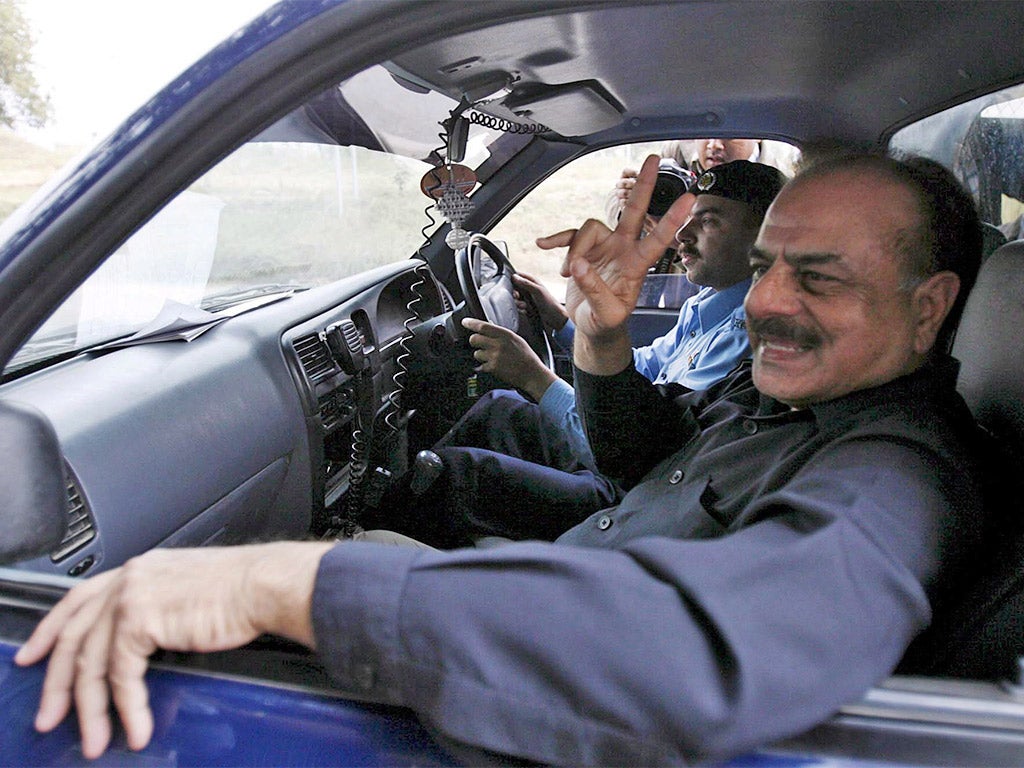Lieutenant-General Hamid Gul: General Zia-ul-Haq’s spymaster who was dismissed by Benazir Bhutto and later accused of supporting terrorism
He supported the mujahedin, whose resistance compelled a Soviet withdrawal, and later the Taliban that emerged from the mujahedin groups

Hamid Gul was head of Pakistan’s Inter-Services Intelligence spy agency for two years in the late 1980s as the Soviet occupation of Afghanistan came to a close. He supported the mujahedin, whose resistance compelled a Soviet withdrawal, and later the Taliban that emerged from the mujahedin groups.
A former tank commander, Gul came to prominence under the government of Pakistan’s military dictator General Zia-ul-Haq, who took power in 1977. Less than a year after Zia’s death in an air crash in 1988, Gul was dismissed by the elected Prime Minister, Benazir Bhutto, who complained that he was abusing his office.
Gul had increased the ISI’s role in Pakistan politics, and had also helped form the IJI coalition – Islami Jamhoori Ittehad, or Islamic Democratic Alliance – to oppose Bhutto’s Pakistan People’s Party in the 1988 elections. It was Gul’s patron, General Zia, who had deposed and executed Bhutto’s father, the PPP founder Zulfikar Ali Bhutto, in the late 1970s.
Gul retained favour with the Pakistan army, however, and after stepping down from the ISI he was appointed to General Zia’s old command, as Commander, II Corps in Multan, retiring from the army in 1992.
The nattily dressed former “jihadi spymaster” remained a highly visible player on the public scene, giving many interviews and appearing frequently on television. Antipathy to him grew among Western governments for his support of the Islamic groups they had outlawed.
In 2010 allegations emerged in leaked US military documents that he had ordered IED attacks against Afghan and international military forces in December 2006, and that he had plotted to kidnap United Nations staff as hostages to barter in exchange for militants. Allegations suggested Gul was still working with ISI two decades after leaving it: the ISI was said to have given 1,000 motorbikes to the militant leader Jalaluddin Haqqani for use in suicide bombings.
Gul denied any continuing connection with the ISI, and dismissed the documents as “utter nonsense... malicious, fictitious, and preposterous – and if this is the condition of US intelligence, then I am afraid it is no wonder they are losing in Afghanistan, and they will lose everywhere they try to poke their nose.” He added: “Reports of my physical involvement with al Qaeda or Taliban in planning attacks on American forces is completely baseless. I am not against America, but I am opposed to what the American forces are doing in Afghanistan.”
But Western dislike of Gul was as nothing to the loathing expressed in India, where many blamed him for working under Zia’s regime to stir up militant pro-Pakistan groups in Jammu and Kashmir, the territory that has been disputed by India and Pakistan since Partition in 1947. “We never quite knew whether Lt Gen Gul had the full backing of the government or not,” said India’s former Intelligence Bureau special director and expert on Kashmir, Amarjit Singh Dulat. “When you speak of the ‘rogue element’ in the ISI, I guess he was the headmaster of rogues.”
It was near the Kashmir border area that Gul had earlier distinguished himself in the 1965 war between Pakistan and India over Kashmir. He was credited with contributing to what has been regarded as a victory for Pakistan in the Battle of Chawinda, by holding back the Indian offensive towards Sialkot. The action has been described as the greatest tank battle since the Second World War, and Pakistan commentators called it “the graveyard of Indian tanks”. Hostilities were ended by a UN ceasefire.
During his army career Gul was decorated with Pakistan’s Sitara-e-Imtiaz, Sitara-e-Basalat, and Hilal-e-Imtiaz (military) – many in the military regard him as a hero and patriot. He had joined the army in 1954 and was commissioned an officer in 1956. He attended Staff College in Quetta and was promoted to battalion commander in 1972. By 1978 he was a brigadier, and in 1980 became Corps Commander of the 1st Armoured Division Multan, as well as martial law administrator for Bahawalpur.
The end of his director-generalship of the ISI, insisted on by a furious Benazir Bhutto, came after the failure of the mujahedin attack on Jalalabad in March 1989, in an attempt to dislodge the communist-backed government of Mohammad Najibullah, and instal one of their own. Gul had planned the assault with the support of the US, but the squabbling mujahedin leaders failed to carry out plans such as blocking the roads to Najibullah’s supply vehicles, and their one advance, in which they took control of the airport to the east of Jalalabad, became stalled, with many thousands killed in the week of fighting that followed.
It was “like Stalingrad” one commentator said, and the future al Qaeda leader Osama bin Laden, then leading his Arab fighters directly into the battle, had a narrow escape from Najibullah’s forces when an informer betrayed the whereabouts of his field headquarters.
Hamid Gul was born in Sargodha, Punjab, where his father, a former Subedar Major in the British Indian Army, had some farmland. The family originally came from Swat in what is now Khyber Pakhtunkwa province – the North-west frontier in British days – where Gul’s grandfather is remembered as having taken part in the 1920s Khilafat movement, a pan-Islamic protest.
Gul was educated locally and then at Government College, Lahore, before going on to Pakistan Military Academy, Kakul. He married, and he and his wife had a daughter, Uzma, and two sons, Umar and Abdullah. He died of a brain haemorrhage while on holiday with his family at the hill station of Murree.
Hamid Gul, soldier and spymaster: born Sargodha, British Punjab 20 November 1936; married (one daughter, two sons); died Murree, Pakistan Punjab 15 August 2015.
Join our commenting forum
Join thought-provoking conversations, follow other Independent readers and see their replies
Comments